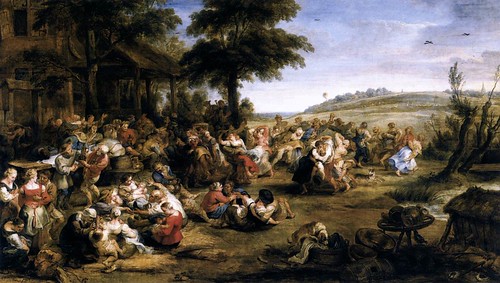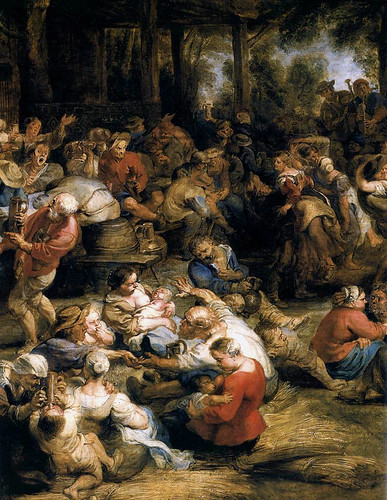
Today’s work of art is by one the most famous artists to ever paint: Peter Paul Rubens. Rubens “was a prolific seventeenth-century Flemish Baroque painter, and a proponent of an extravagant Baroque style that emphasized movement, color, and sensuality. He is well-known for his Counter-Reformation altarpieces, portraits, landscapes, and history paintings of mythological and allegorical subjects.” Today’s painting was done toward the end of his life, around 1635-38, though others believe he may have started it much earlier in 1620, but then returned to it later. It’s known as the Village Fête, and sometimes as the Village Wedding.

The paintings hangs in the Louvre, which describes it as follows:
The picture, painted late in the artist’s life, around 1635-38, is manifestly neo-Bruegelian in inspiration. The pig’s snout poking out of the sty on the right is an ancient symbol of gluttony (gula). According to those who date the picture in the 1620s, the landscape was painted before the figures, which are in Rubens’ late lyrical style.
This monumental picture, also called the Village Wedding, is in the northern tradition of depictions of village fêtes. Pioneered by Pieter Bruegel, the enormous popularity of this genre contributed to the renown of the Flemish School. These compositions often had a moral message, denouncing the baseness of the human condition by showing it in all its excesses. However, even though a pig’s snout — a symbol of gluttony — can be seen poking out of the sty in the foreground, denouncing vices was not Rubens’ main preoccupation.
While there’s dancing going on on the right half of the painting, the lower left is consumed with drinking beer. You can see it better in the detail of the painting below.

You can see all of Ruben’s works online at the Complete Works or Peter Paul Rubens. There’s also a biography on Wikipedia, and more information at the Web Museum, the Art Archive , ArtCyclopedia and Olga’s Gallery.
